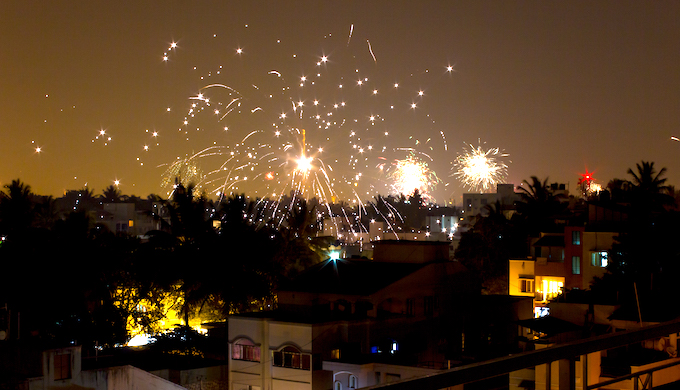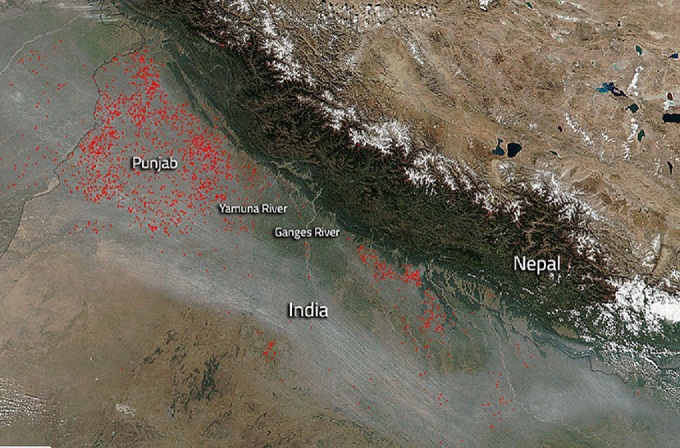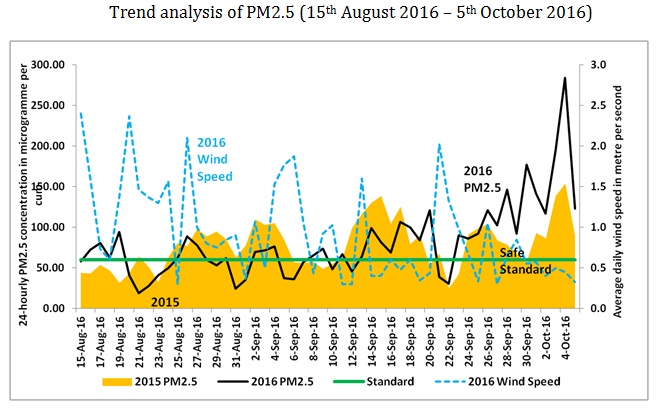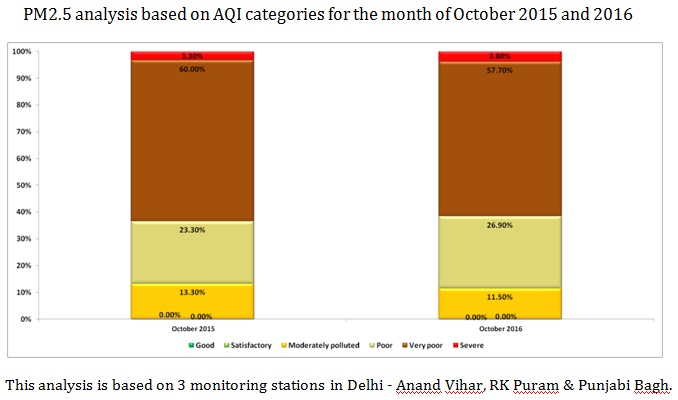As pollution levels rise in India’s capital before Diwali celebrations, the only step the state government seems to be taking is banning Chinese firecrackers

Diwali fireworks add massively to Delhi’s air pollution. (Photo by Silver Blue)
As Diwali, the festival of lights, approaches, the Delhi government is cracking down on Chinese firecrackers in a bid to stop the rise in air pollution. Delhi, other than being India’s capital, is also the city with the most polluted air on the planet. Of special worry are PM 2.5 levels, particulate matter that are less than 2.5 microns in width. These are able to bypass the defence systems of the body and can even penetrate the bloodstream, making them particularly dangerous.
As PM 2.5 levels increase primarily as a result of burning, Diwali is especially risky. Setting off firecrackers is a traditional way of celebrating. In rural areas, the burning of lamps in northern India has historically been a way to offset the high incidence of insects during the harvest season. In an urban area like Delhi, already suffering from heavy vehicular pollution and the smoke from stubble being burnt in farms all around the capital, the addition of pollution by firecrackers is a disaster.

NASA’s Suomi NPP satellite image taken on 23 October 2016 shows agricultural fires (marked in red) in the Punjab region of India. (Source: NASA)
Banning Chinese firecrackers
As a response, the Delhi government has banned the sale of Chinese firecrackers. These have high sulphur content, which makes for brighter fireworks. As many as 11 teams have been formed in the capital, headed by sub-divisional magistrates (SDMs), to crack down on shops importing toxic crackers illegally. The teams will also conduct surprise inspections and take action against sellers and buyers of illegal crackers.
According to Imran Hussain, Delhi’s environment minister, “To make people aware, we are taking out advertisements in newspapers and on the radio. Anti-cracker campaigns are also ongoing in schools and colleges.”
But limiting the sale of China-made firecrackers hardly seems to be enough of a response. For one, there is no real estimate of the extent by which Chinese firecrackers are responsible for the pollution. According to Anumita Roychowdhury, head of the air pollution and clean transportation programme at non-profit Centre for Science and Environment (CSE), “The government is just talking about Chinese crackers. The whole thing is hijacked by the drive against Chinese crackers. Why only Chinese crackers? There is a huge volume of other crackers as well in the market which when burnt will cause severe pollution.”
She added, “The government needs to bring in strict measures to control licensing and really aggressive campaigns. We can’t just keep on talking about the need to take strict actions to cut air pollution year after year.”
The problem of PM 2.5
Air pollution in Delhi is due to a combination of various factors. According to a report commissioned by the Delhi government, the single largest contributor to air pollution is road dust – accounting for 56% of PM 10 and 38% of PM 2.5. Vehicles add another 9% to the PM 10 pollution, and 20% to the PM 2.5 pollution. Domestic fuel burning adds another 12%. It is hard to hard to say to what extent firecrackers, and especially Chinese firecrackers, are responsible.
Delhi’s problem is compounded by the fact that it is surrounded by states such as Haryana and Punjab and Uttar Pradesh, where fields are burnt after the harvest to clear the stubble. The weather pattern during autumn means this pollution not only gathers around the city, but also, that the winds do not disperse it.
“After summer monsoon air becomes cooler, wind becomes calmer, this lowers the mixing height of air and hence air and wind don’t rise enough and pollution gets trapped,” said Roychowdhury.
It is just at this time that a huge amount of firecrackers go off in Delhi, leading to an explosion of air pollution.
This year and the last

(Source: CSE analysis based on real time data from the Delhi Pollution Control Committee, According to CSE, The data is available only till 7 October as DPCC monitoring stations stopped working after that.)
This year Delhi already has a lot to worry about. According to data collected by CSE from the Delhi Pollution Control Committee (DPCC), PM 2.5 levels are already higher than they were last year, and significantly above the safe limits. Sunita Narain, director general of CSE and member of the Environment Pollution (Prevention and Control) Authority (EPCA) appointed by the Supreme Court of India, said Delhi’s air was already so polluted that there was no space to enjoy this holiday.
Experts say the only crucial step that has been taken so far in the last year to curb air pollution in Delhi is imposition of an environment compensation charge (ECC) on trucks. This has led to a visible dip in air pollution, and Delhi’s PM 2.5 levels were lower than last year’s until almost the end of September. Unfortunately, after September 25, fires started at landfill sites to dispose of garbage, and at the beginning of October farmers in Punjab, Haryana and Uttar Pradesh started clearing their fields by burning stubble. This was matched by a fall in temperature, and all of this combined to make the pollution levels jump above last year’s.
There were no days when the pollution levels were good, or even satisfactory. The best air quality that Delhi experienced in October was “moderately polluted” and even this was only 13.3% of the days in 2015, and 11.5% this year.

(Source: CSE analysis based on real time data from the Delhi Pollution Control Committee)
Change the air
EPCA has launched a mobile app called Hawa Badlo (Change the Air), which citizens can use to report on incidences such as garbage burning, one of the main causes of the increase in PM 2.5 levels. According to Bhure Lal, chairperson of EPCA, “The app aims at an inclusive participation of citizens in reporting incidences of leaf and garbage burning, building and construction dust and unpaved road dust, and thereby makes them part of the city’s fight to curb toxic air pollution.”
Narain added, “The app is expected to act as an accountability, public information dissemination and public engagement mechanism.”
However, EPCA has urged that further priority actions for control of air pollution in winter are needed such as:
- Strict enforcement of pollution norms on Delhi-bound trucks;
- Urgent action to control pollution from thermal power plants in Delhi and its vicinity by shutting down plants during winter months and moving towards natural gas based plants and to tackle fly ash pollution as well;
- Strict action by Punjab, Haryana and Uttar Pradesh to stop biomass burning and providing the farmers alternatives to use paddy straw for energy and for tilling into ground for manure;
- Enforcement of all actions and directives to move vehicles towards BS IV (nationwide) by April 2017; BS VI (nationwide) by April 2020;
- Comprehensive steps to augment public transport in Delhi including bus, rail, metro and walk and cycle for last mile connectivity and increasing parking charges.
However, despite the urgency to improve the air quality, the steps to cut air pollution are going on at a snail’s pace. For instance, Delhi government was to procure 2,000 buses to augment public transport but they have just managed to buy four.
“Last year we saw very intense discussions on air pollution and we had a year to prepare. It is a serious public health issue. Even hospitals’ data shows that emergency cases of cardiac and respiratory ailments increase every winter. So we need much more aggressive, hard actions,” said Roychowdhury.
Talking about the minor improvement in the air quality as noticed just before September 25, she said, “It shows that if you act, you will be able to taper off the peaks. The levels are still unacceptably high but overall it is like just a beginning of the bending of pollution curve. But hard actions need to be taken.”
Banning Chinese firecrackers is unlikely to be enough.

Trackbacks/Pingbacks